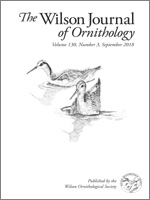We used sequences of the mitochondrial ND2 gene, the nuclear TGFB-2 intron-5, and differences in plumage pattern to assay geographic variation in the Red-bellied Woodpecker (Melanerpes carolinus). Ten population samples from throughout its range indicated that ∼23% of the mitochondrial genetic variation was distributed among populations, largely due to the occurrence of a clade of haplotypes restricted to the Florida peninsula with a local frequency of 82%. In a hierarchical analysis, 37% of the mtDNA genetic variance was distributed between the Florida peninsula and elsewhere. A strong signal of population growth was detected in the non-peninsular portion of the range. Otherwise, geographic variation in haplotype frequencies was minor, with no evidence of isolation-by-distance. Nuclear intron data showed little variation among populations (Fst = 0.007). These results suggest recent secondary contact of 2 differentiated taxa following expansion from allopatric Pleistocene refugia. We modeled the transition in haplotype frequencies along the Florida peninsula as a zone of neutral introgression; the estimated width of that zone was 435 km, and its center was near present day Ocala. Variation in plumage pattern along the peninsula previously had been used to describe a subspecific taxon, M. c. perplexus. We used variation in the forehead pattern of adult males from along the east coast of the United States to model this phenotypic transition; the zone had an estimated width of >2,500 km and an approximate center in the Florida Keys. Taken together, the geographic patterns in mtDNA and plumage variation suggest the populations of Red-bellied Woodpeckers on the Florida peninsula differentiated from those elsewhere during isolation; they are now in secondary contact in a well-known suture zone and represent 2 phylogenetic species connected by wide molecular and morphological zones of introgression.
How to translate text using browser tools
1 September 2018
Phylogeography and geographic variation in the Red-bellied Woodpecker (Melanerpes carolinus): characterization of mtDNA and plumage hybrid zones
George F. Barrowclough,
Jeff G. Groth,
Elizabeth K. Bramlett,
Jonas E. Lai,
William M. Mauck
ACCESS THE FULL ARTICLE
Hybrid zones
Melanerpes carolinus
Nd2
phylogeny
PHYLOGEOGRAPHY
suture zones
TGFB-2





